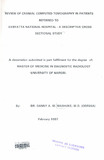Abstract
Morphological brain and skull abnormalities are fairly common; however, they are often difficult to diagnose. By using specific imaging criteria, one may readily diagnose these abnormalities. In this study an attempt has been made to illustrate the spectrum of imaging findings seen on computed tomography (CT), in the evaluation of brain abnormalities such as; congenital malformations, hydrocephalus, atrophic conditions, vascular and traumatic lesions. A total of 200 patients were considered in this study with Male Female ratio of 1.3:1. 123 (61.5%) were inpatients while 77(38.5%) were out-patients. The age of patients ranged from 4 months to 90 years. Most of patients in the study had provisional diagnosis indicated by referring clinician as; Congenital brain lesions (15.5%), Raised intracranial pressure (23.5%), Brain tumours (13%), Vascular less ions (6%), Infection and Infestations (9%), Traumatic brain lesions (15.5%) and other conditions (17.5%). Evaluation of the types of brain lesions referred to KNH using C.T. and their association with demographic data (age, sex, and region referred from) is established. Views on the accuracy of the provisional diagnosis given by the referring clinician from the wards or out-patient clinics are discussed. It is hoped 'that the. result of this study may influence the use of CT by physicians looking after patients with brain and skull abnormalities
Description
A Dissertation Submitted In Part Fullfilment For The Degree Of:
Master Of Medicine In Diagnostic Radiology
University Of Nairobi

